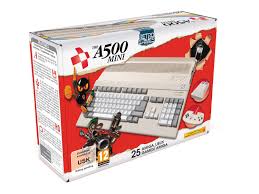
The Original Price of the Amiga 500
The Amiga 500, a popular home computer released by Commodore in 1987, had an original price of $699 USD. This price included the computer itself, a keyboard, and a mouse. The Amiga 500 was known for its advanced graphics and sound capabilities, making it a favorite among gamers and multimedia enthusiasts.
Despite its relatively high price compared to other home computers at the time, the Amiga 500 offered superior performance and functionality, attracting a dedicated fan base. Its innovative features and strong software support helped establish it as a leading computer in the late 1980s and early 1990s.
Over time, as technology advanced and newer models were released, the price of the Amiga 500 decreased. However, its impact on the computer industry and its place in computing history remain significant to this day.
Today, collectors and retro computing enthusiasts often seek out the Amiga 500 to experience its unique capabilities and nostalgic charm. Despite being decades old, the Amiga 500 continues to hold a special place in the hearts of many who remember its original price tag and what it represented in the world of computing.
Unveiling the Past: The Original Pricing of the Amiga 500 and Its Historical Significance
- What was the original price of the Amiga 500?
- How much did the Amiga 500 cost when it was first released?
- Was the Amiga 500 expensive when it first came out?
- Did the price of the Amiga 500 change over time?
- What factors influenced the pricing of the Amiga 500?
- Is the original price of the Amiga 500 a significant aspect of its history?
What was the original price of the Amiga 500?
One of the most frequently asked questions about the Amiga 500 is regarding its original price. The Amiga 500 was initially priced at $699 USD, which included the computer itself, a keyboard, and a mouse. This price point positioned the Amiga 500 as a premium home computer offering advanced graphics and sound capabilities. Despite its relatively higher price compared to other models at the time, the Amiga 500’s performance and features made it a popular choice among gamers and multimedia enthusiasts. The original price of the Amiga 500 reflected its innovative technology and positioned it as a leading computer in the late 1980s and early 1990s.
How much did the Amiga 500 cost when it was first released?
The original price of the Amiga 500 when it was first released in 1987 was $699 USD. This price included the computer itself, a keyboard, and a mouse. Despite being relatively expensive compared to other home computers at the time, the Amiga 500’s advanced graphics and sound capabilities justified its cost and made it a popular choice among gamers and multimedia enthusiasts. Its initial price point reflected its cutting-edge technology and positioned it as a premium option in the home computer market of the late 1980s.
Was the Amiga 500 expensive when it first came out?
When the Amiga 500 was first released, it was considered relatively expensive compared to other home computers on the market at the time. Priced at $699 USD, the Amiga 500 included advanced features such as superior graphics and sound capabilities, which justified its higher price point. While some consumers may have found it to be a significant investment, many recognized the value of the Amiga 500’s performance and functionality. Over time, as technology evolved and newer models were introduced, the price of the Amiga 500 became more competitive. Despite its initial cost, the Amiga 500’s innovative features and strong software support helped establish it as a popular choice among gamers and multimedia enthusiasts in the late 1980s and early 1990s.
Did the price of the Amiga 500 change over time?
The price of the Amiga 500 did change over time. When it was first released in 1987, the original price of the Amiga 500 was $699 USD, which included the computer, keyboard, and mouse. As technology progressed and newer models were introduced, the price of the Amiga 500 gradually decreased. Discounts, promotions, and market demand also influenced fluctuations in its price over the years. Today, due to its status as a vintage collectible item, the cost of purchasing a well-preserved Amiga 500 in good working condition can vary significantly depending on factors such as rarity, condition, and included accessories.
What factors influenced the pricing of the Amiga 500?
The pricing of the Amiga 500 was influenced by several key factors. Firstly, the advanced technology and capabilities of the Amiga 500, such as its superior graphics and sound performance, contributed to its higher price point compared to other home computers of the time. Additionally, the cost of manufacturing and components, including custom chips developed specifically for the Amiga series, played a significant role in determining its price. The marketing strategy employed by Commodore to position the Amiga 500 as a premium product aimed at gamers and multimedia enthusiasts also impacted its pricing. Overall, a combination of technological innovation, production costs, and market positioning were key factors that influenced the original price of the Amiga 500.
Is the original price of the Amiga 500 a significant aspect of its history?
The original price of the Amiga 500 holds significant importance in its history as it reflects not only the economic landscape of the late 1980s but also the positioning of the computer within the market. Priced at $699 USD upon its release, the Amiga 500 was considered a premium home computer, offering advanced features and capabilities that justified its higher cost. This pricing strategy played a role in shaping the perception of the Amiga 500 as a high-performance machine tailored for gaming and multimedia tasks. The price point also influenced consumer expectations and market positioning, contributing to the Amiga 500’s legacy as an iconic computer that pushed boundaries in both technology and affordability for its time.
